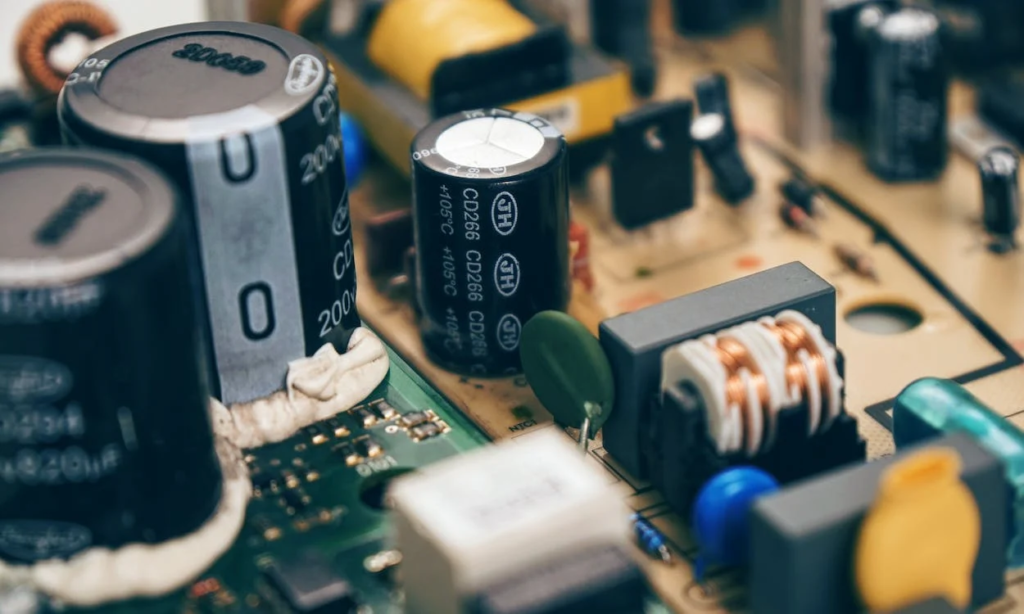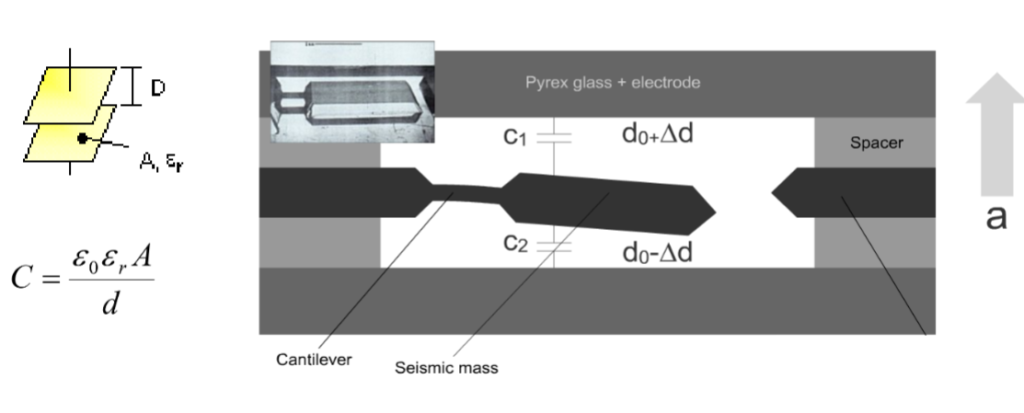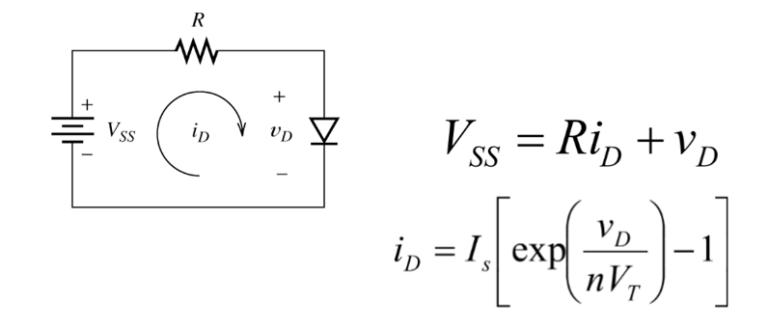Capacitors Basics
What are capacitors? In the realm of electrical engineering, a capacitor is a two-terminal electrical device that stores electrical energy by collecting electric charges on two closely spaced surfaces, which are insulated from each other. The area between the conductors can be filled with either a vacuum or an insulating material called a dielectric. Initially termed the condenser, this name is still found in some compound names, like the condenser microphone.

Capacitors, alongside resistors and inductors, constitute some of the most fundamental passive components utilized in electronics. It would be challenging to find a circuit devoid of a capacitor. In this article, we’ll dive into the world of capacitors and uncover how they work and why they are so essential for electronic circuits.
History of Capacitors
In 1745, Ewald Georg von Kleist discovered that charge could be stored by connecting a high-voltage generator to water in a glass jar. This setup, acting as a primitive capacitor, produced a powerful spark when touched. The following year, Pieter van Musschenbroek created a similar device known as the Leyden jar, named after the University of Leiden. Both scientists were amazed by the shock produced by these early capacitors.
In 1957, H. Becker invented electric double-layer capacitors, now known as supercapacitors, with a patent for a “Low voltage electrolytic capacitor with porous carbon electrodes.” Becker believed that the energy was stored as a charge in the carbon pores of his capacitor, similar to the pores of etched foils in electrolytic capacitors. He acknowledged in the patent that the exact mechanism of energy storage was unknown but noted the component’s extremely high capacity.
The metal–oxide–semiconductor capacitor (MOS capacitor) evolved from the metal–oxide–semiconductor field-effect transistor (MOSFET) structure, which was invented by Mohamed M. Atalla and Dawon Kahng at Bell Labs in 1959. The MOS capacitor became widely used as a storage capacitor in memory chips and as the fundamental component of charge-coupled devices (CCDs) in image sensor technology. In dynamic random-access memory (DRAM), each memory cell typically includes a MOSFET and MOS capacitor.
What is a Capacitor in simple words?
A capacitor is like a small electronic storage tank that stores electrical charge. A capacitor is similar to a battery in some ways but operates quite differently. While a battery converts chemical energy into electrical energy, a capacitor is an electronic component that stores electrostatic energy within an electric field. Imagine it as a rechargeable battery but without the ability to produce a continuous flow of electricity. Instead, it can store and release energy when needed.

Inside a capacitor, there are two conducting metal plates, separated by an insulating material called a dielectric. The plates can be made of different metal alloys, such as aluminum or tantalum, depending on the type of capacitor. The dielectric material helps maintain a separation between the plates, preventing them from touching.

How capacitors work
Now that we know what a capacitor is, let’s talk about how it works. When a voltage is applied to a capacitor, it starts charging up, storing electrical energy in the form of electrons on one of the plates. The other plate becomes positively charged to balance things out. This charge separation creates a voltage potential between the two plates and an electric field between the plates, storing the energy.
Here’s where it gets interesting. When the voltage source is removed, the capacitor retains the charge. This stored energy can be released when needed, making capacitors great for a wide range of applications. The process of charging and discharging is what makes capacitors so versatile and valuable in electronic circuits.
What does capacitance tell us?
Capacitance tells us how much electrical charge a capacitor can store per unit of voltage. It quantifies the ability of a capacitor to hold and release energy. In simpler terms, it measures the “size” of a capacitor’s storage tank for electrical charge.

The capacitance of a capacitor is measured in a unit called the farad. Now, a farad is a pretty big unit, so capacitors used in everyday electronics are usually measured in microfarads (µF), nanofarads (nF), or even picofarads (pF). These smaller units represent a fraction or multiple of a farad, depending on the size of the capacitor.
How to calculate the capacitance of a parallel plate capacitor?
The capacitance of a parallel-plate capacitor is determined by the area of the plates, the distance between them, and the permittivity of the dielectric material between the plates, see picture and equation below.

where,
- C is the capacitance in farads,
- A is the area of overlap of the two plates in square meters,
- εr is the relative static permittivity (dielectric constant) of the material between the plates,
- ε0 is the electric constant (ε0≈8.854×10−12 F m⁻¹),
- d is the separation between the plates in meters.
This formula is fundamental in understanding the capacitance of a simple capacitor and is derived from the geometry and physical properties of the materials involved.
Energy storage in capacitors
This formula shown below explains how the energy stored in a capacitor is proportional to the square of the voltage across it and the capacitance of the capacitor. It’s a crucial concept in understanding how capacitors store and release energy in electronic circuits.
E=0.5CV2
Where:
- E is the energy stored in joules,
- C is the capacitance in farads,
- V is the voltage across the capacitor in volts.
Geometric means to enhance capacitance
To enhance capacitance, several geometric means can be employed. First of all you can try decreasing the separation between the capacitor plates. As the electric field between the plates becomes stronger so does the capacitance. Secondly, increasing the area of the facing plates, effectively adding more internal surfaces, also boosts capacitance by allowing more charge to be stored.
Additionally, connecting capacitors in parallel increases the total capacitance by effectively adding their capacitances together. Lastly, using a material with a high dielectric constant between the plates further increases capacitance by enhancing the electric field strength and charge storage capacity.
Types of capacitors
Okay, let’s talk about the different types of capacitors you might come across. The world of capacitors is diverse, with each type having its characteristics and applications. Here are a few common types you might encounter:

- Electrolytic capacitors: These are polarized capacitors commonly used for high capacitance values. They are often found in power supply circuits and audio systems. Just remember to connect them in the correct polarity, or they might go “boom”!
- Ceramic capacitors: These are small and inexpensive capacitors used in a wide range of applications. They come in various sizes and capacitance values, making them versatile for different circuit needs. You’ll find them in everything from computers to radios.
- Tantalum capacitors: Similar to electrolytic capacitors, tantalum capacitors are polarized and offer high capacitance values. They are known for their stability and reliability, making them suitable for applications where accuracy is crucial, like medical devices and automotive electronics.
- Film capacitors: These capacitors are made from a thin film of metal or metalized film. They come in different types, such as polyester, polypropylene, and polystyrene, each with specific characteristics. Film capacitors are commonly used in audio systems and electronic filters.
Some capacitors are polarised, they can only be connected one way around. Electrolytic capacitors are polarised.
What is a practical capacitor?
A practical capacitor is a type of capacitor that consists of two sets of semicircular aluminum or brass plates separated by a dielectric material. Practical capacitors can be constructed by interleaving the plates with two dielectric layers and rolling them up. By staggering the plates, connections can be made to one plate at each end of the roll.

Capacitors in electronic circuits
Now that we know about different types of capacitors, let’s explore why they are essential in electronic circuits. Capacitors play various roles and have a multitude of applications. Here are a few examples:
- Power supply filtering: Capacitors smooth out the voltage provided by power supplies, reducing any ripples or fluctuations. They act as a buffer, ensuring a stable and reliable power source for the rest of the circuit components.
- Timing circuits: Capacitors, in conjunction with resistors, can create precise time delays or oscillations in circuits. This is useful for generating clock signals, timing events, or creating frequency references.
- Coupling and decoupling: Capacitors allow AC signals to pass through while blocking DC components. They are used for coupling different stages of amplifiers, allowing the AC audio signal to flow while blocking the DC bias. Additionally, decoupling capacitors provide a local reserve of charge to prevent voltage drops and minimize noise in sensitive circuits.
- Motor starting and suppression: Capacitors are employed in electric motors to provide an initial boost during startup. They help overcome the high starting current and improve the motor’s efficiency. Capacitors are also used to suppress electromagnetic interference (EMI) generated by motors and other high-power devices.

What happens when a capacitor is connected in parallel?
When capacitors are connected in parallel, their total capacitance increases. This means that the combined capacitors can store more electrical charge. Connecting capacitors in parallel is like expanding the storage capacity by adding more tanks to hold the charge since the equivalent capacitance is the sum of individual capacitances of all capacitors involved.

What happens when capacitors are in series?
When capacitors are connected in series, their total capacitance is less than any capacitors’ capacitances. This is because the voltage across each capacitor in a series circuit is the same, but the total charge stored is divided among the capacitors. The capacitance of two or more capacitors in a series circuit is inversely proportional to the sum of the reciprocals of the individual capacitances.

How does a capacitive acceleration sensor work?
A capacitive acceleration sensor works by using the principle of capacitance change due to acceleration. It typically consists of a movable mass attached to one of the capacitor plates. When the sensor experiences acceleration, the mass moves, altering the distance between plates, which changes the capacitance, allowing measurement of the acceleration.

Conclusion
And that’s a wrap, folks! We’ve taken a journey into the world of capacitors, understanding their basic principles and significance in electronic circuits. Capacitors may seem like small and simple components, but they play a vital role in the devices we use every day.
Whether it’s filtering power supply voltage, providing precise timing, coupling signals, or starting motors, capacitors are the unsung heroes behind the scenes. So, next time you pick up your smartphone or turn on your favorite gadget, remember that capacitors are working diligently to make it all possible.






